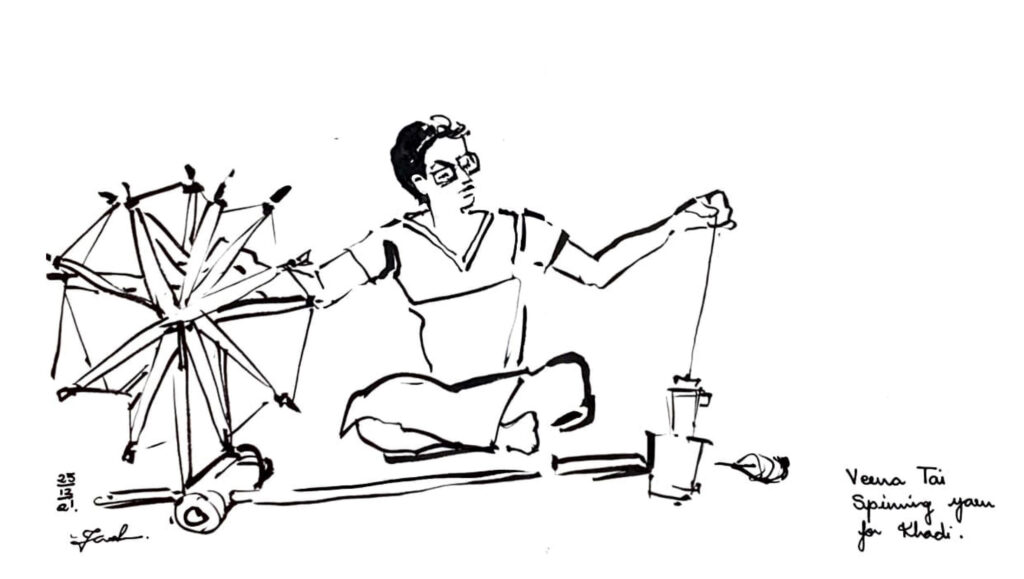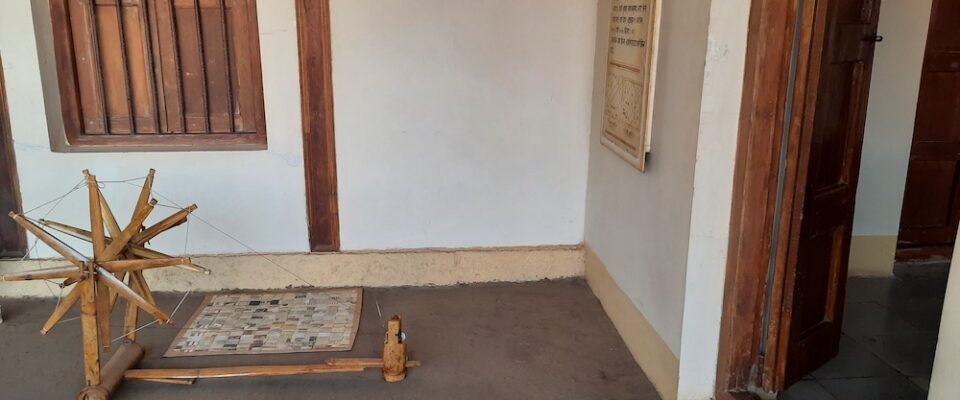Khadi
The discipline of spinning khadi is one of the fundamental practices recommended by Mahatma Gandhi. Taking this teaching to heart, most Sarvodaya members spin khadi for at least for one hour on a daily basis. The effect of this activity in creating a mental balance and still mind are very valuable to modern life. The khadi yarn that is produced is sent to Wardha, Maharashtra, to be woven into fabric and then comes back to the members of the community to be converted into garments. The spinning wheel, known as the Charkha became a very important symbol of the freedom movement.
Workshops to teach people how to spin khadi are conducted by the community on a regular basis both at Gagode as well as in Pune city. Vinoba founded Ashrams and organization on the basis of Charkha and Farming. He wanted that voluntary workers and organization should become self-sufficient in food and clothing. At the Vinoba Janmasthan, workers spin regularly. Three types of charkhas – Kisan Charkha , Peti Charkha and Ambar Charkha – are in use at present. One of the trustees of Janmasthan, Madhav Sahasrabudhe has been involved in teaching and spreading spinning activity widely across India through trainings and workshops. His book on spinning also has been published.
In 1916 Vinoba joined Gandhi. From then until the beginning of the Bhoodan movement, over three decades he worked for khadi improvement. He experimented on the process of spinning and spun daily for eight hours. Credit for the khadi production of today is therefore due to Vinoba. For him Charkha was more of a symbol of his concepts of Gramrajya and Ramrajya. Charkha was chief component for unity of upper and lower class. In his words ‘Charkha was a flagship of resistance against pre-established dogmatic system’.
If food and clothes are considered as primary needs of men then everyone must have knowledge about the same. Vinoba called agriculture as “Anna-Purna” and Charakha as “Vastra-Purna“. The word ‘Purna’ means sufficient, so he was inviting people to become self sufficient in food and clothing. Charkha is a symbol of non-violence. If one wants to take a path of non-violence then Charkha should be the first step. He believed that the daily practice of spinning on the Charkha provides creative and emotional satisfaction both.
Vinoba pointed out that if ever citizen gave half an hour from their daily routine to spinning yarn on Charkha then the entire country could become independent as far as clothing was concerned. To prove his point , he used an analogy of brushing teeth. This activity, which is done personally by each individual takes hardly ten minutes, However if we were to hire a worker to brush the teeth of each person, one worker may take upto 8 hours to brush the teeth of 50 individuals. If one were to apply this similarly to the spinning of yarn, it would be extremely efficient for each individual to take responsibility of his own clothing. The industrialisation of cloth production is inefficient and also impacted peoples lives. It broke down the rural economy and converted people to labourers.
This further which led to class struggle and was the cause of much conflict.
Anyone who uses self made / self spun clothes vouches that, happiness and satisfaction from wearing that self spun cloth is unmatchable. This thought ultimately makes one realize that “I’m not a slave of anybody and neither will I enslave anyone” and this very emotion will lead us to make a non-violent, unexploited society.
Lastly, Vinoba said that khadi is a symbol of unity. It is a symbol of non-violence and empowerment of the poor. Therefore even if hand spun khadi is more expensive, one must be willing to pay the price for it as it benefits society at large. The use of Khadi, the support of the Khadi movement requires generosity and sacrifice. This is why it is not just a mere fabric but an entire belief system.


